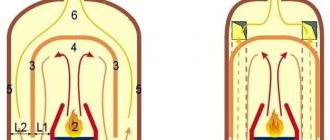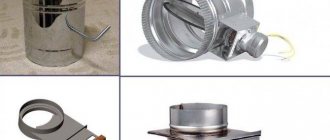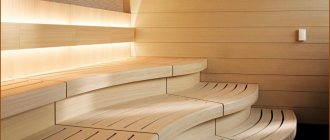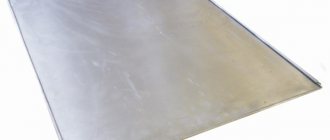A homemade metal stove is perfect for heating a greenhouse, garage, work space, and even a living room. To assemble the unit in question, you can use sheets of metal, barrels, pipes and even fire extinguishers of a suitable size. The procedure for making the stove remains the same. Differences are present only in the initial stages of corps preparation.
DIY metal stove
Pros and cons of metal stoves
To begin with, we can look at the main advantages of the design for private use:
- It is easier to get certified - every device in the house must be checked by a special authority, after which its safety is recognized. Devices that are made according to the drawings of metal furnaces without making mistakes are approved without any questions.
- High thermal conductivity - the materials are non-porous, heat up well and quickly. This point is more about efficiency; for heating a small room, like a bathhouse or utility room - such a stove will be enough.
- Cheap - the low cost is regulated by the fact that such a stove can be created with your own hands without special skills. The main thing is to have blanks of material on hand, as well as a welding machine, which can also be rented or free from friends.
Now about the disadvantages of a metal sauna stove:
- Such stoves do not “breathe” - if a brick, when heated, absorbs the air around it, thereby slowly but effectively heating it, then the metal quickly cools down and requires more resources for heating.
- Risk of fire - the walls become so hot that nearby objects can easily ignite.
- Short service life - as practice shows, the service life is a maximum of 20 years. Much depends on the frequency of use and conditions, the material is susceptible to corrosion, even the thickest walls will be destroyed at high temperatures.
If we are talking about equipping a bathhouse or a small room, then which option is quite suitable. The main thing is to build the structure taking into account the operating rules; the dedicated instructions will help with this.
How the stove works
For a steam room, a heater will suffice, under which there will be a firebox that heats the stones to 250 degrees. Thanks to this, you can obtain the necessary steam for the sauna.
The bathhouse has a different microclimate, which is created by small droplets that heat the air to 150 degrees Celsius. Due to this, the steam is called dry. We get dry steam only at temperatures above 500 degrees.
How to choose metal for the stove
Technical characteristics depend on the material from which the stove will be made. Therefore, you need to pay special attention to this nuance. Most often, craftsmen make a device from what is already in the utility room or barn.
However, this is not an entirely correct approach; the following options must be taken into account:
- Structural steel - can withstand temperatures up to 400 degrees, it is better to choose sheets of at least 4 mm. It won’t be possible to use it often, as it can easily burn out in one winter. If it is used for a bathhouse that is heated once a week, it will last a long time.
- Heat-resistant steel - this option can withstand 30 years of operation. The thickness should be at least 1 cm. Many stores sell a ready-made structure that only needs to be assembled; no welding is required, which is very convenient and profitable.
- Cast iron takes a long time to heat up, but retains heat well and heats the room. They have a long service life; such stoves can provide heat every winter for 30-40 years. The material is quite expensive, but fully justifies itself. Self-production is a rather complicated process. Such a device is often used to heat greenhouses and outbuildings. It is advisable to choose thick material, since sheets up to 1 cm will crack at the first temperature change.
Based on these recommendations, you can choose a good material for making a metal stove with your own hands.
Construction, material base
A traditional Russian stove is a massive stone structure of intermittent operation, heating and cooking type, equipped with a stove bench.
Thanks to its high heat capacity, the stove accumulates heat and releases it into the room for a long time after heating. Therefore, the room does not get cold, even if it is not possible to continuously maintain the fire. The standard dimensions of a Russian stove were tied to arshins, but when converted to the usual centimeters they are usually rounded.
- Length – 3 arshins (about 213 cm, now 210 cm).
- Width – 2 arshins (about 142 cm, now 140 cm).
- The height to the bed is 2.5 arshins (about 178 cm, now 180 cm).
A Russian stove of this size could heat a room of about 40 m². With the use of modern energy saving technologies, this area can be significantly increased. What then, what now, the shape can be whatever you want, but the design of the classic Russian stove is unchanged.
- Ward - a foundation (stone, brick, concrete, wood); if the guard was wooden, it was combined with an under-furnace.
- Podpechek (podpechok) - a cavity under the stove intended for storing and drying fuel.
- The hearth (vault) is the base of the furnace, insulated with backfill (sand, brick chips, expanded clay), which ensures optimal temperature in the cooking/oven zone.
- A stove is a small cavity for storing dishes, if located in the front part, it is called a subrack.
- The shelf is a platform in front of the furnace, where cooked food is left after being removed from the oven.
- Under – the base of the cooking zone, is made with a slight slope forward (so that the gases collect under the arch, and it is more convenient to move the dishes).
- The crucible (cooking zone, firebox) - fuel combustion and food preparation take place in it.
- The vault (sky) is the upper part of the furnace, rectangular, arched or barrel-shaped, with a backfill on top to prevent direct heating of the stove bed.
- A bed (floor, roof) is a platform above the furnace, intended for resting or sleeping, one of the main elements of the classical design.
- Overpipe - the top, a chamber above the pole, ending with a tapering nozzle (hail), in which smoke collects, giving off heat to the house before being discharged into the chimney.
- View - a valve with a hole above the hilum, located behind the door, through which the flow of cold air from the pipe is regulated.
- Pipe (chimney).
- The valve is located in the pipe, above the view, and allows you to completely close the chimney.
And an example of a stove with a stone base.
In the classic version, Russian stoves are bell-type structures with a channelless convective system. Since the heat source is located almost a meter high from the floor, and in the oven there are not only no channels, but it is also insulated, the temperature difference in the room can be more than ten degrees. In modern stoves used for cooking and heating, this problem is solved by installing chimneys instead of ovens, ensuring uniform heating of the room at all levels. And there can be several fireboxes, depending on the required functionality.
Increasingly, outdoor complexes are being built on the basis of Russian stoves, the main task of which is to prepare dishes in various modes. These stoves no longer have a bench, they are much smaller in size, and to maintain the temperature in the cooking zone as efficiently as possible during construction, thermal insulation materials are used.
Another modification is to make a small firebox under the hearth so that you can cook in the warm season without having to heat the entire oven and room. Often in such ovens, the firebox above the firebox is equipped with grates to create a barbecue, or a metal hob is installed.
As for the masonry material, the best option is a special oven brick designed for high heat. But structures made of red solid brick, in combination with fireclay in the area of the firebox and mouths, are also quite viable.
The main condition is that the brick must be of high quality, not burnt, with a smooth surface and good geometry, since the seams are thin and it will not be possible to play with mortar.
There are decorative bricks with chamfers and arched ones on sale, but many process ordinary bricks - both economically and manually.
Today there are no problems with various specialized masonry mortars, although our predecessors got by just fine with mixtures based on fatty clay and river sand. Before use, the clay was thoroughly crushed and sifted, and the sifted sand was calcined. The proportions varied - either sand and clay in equal parts, and water one part of the volume, or more sand (up to five parts). Since difficulties usually arise with the right clay, there are not only ready-made mixtures on sale, but also oven clay separately. A brick oven without further finishing also looks aesthetically pleasing, but if desired, it can be lined. Stoves plastered with clay and whitewashed will look organic only in an appropriately decorated room.
Classification of metal furnaces
There are several types of stoves, which also differ from each other in performance characteristics. Briefly about three options for everyday life:
- Chamber ones are popularly known as “potbelly stoves”. The chimney is shortened to 2 meters; when the fuel burns out, the remaining flue gases contribute to combustion. Efficiency is 60%; such a device is cleaned 1-2 times a year. The main advantage is that there is no condensation, because the chimney heats up to 100 degrees and any liquid simply evaporates.
- Duct - inside there is a labyrinth of gas tubes. Operates on the principle of a burner. The efficiency is higher than in the previous version and is 80%. Can be used in several modes - flame and “afterburning”.
- Bell-type - when properly designed, gives an efficiency of 80%. It can run on coal due to the combustion of fuel in the bell. You can even heat a house of 60 square meters.
Each person decides which option to choose for household needs individually. Any type can be built with your own hands.
Main manufacturers
Let's look at the most popular manufacturers on the modern metal furnace market.
Teplodar
Teplodar - model “Vertical” (increased long-burning mode gives 8 hours of heating without adding fuel), “Stove” is equipped with a hob with removable rings, “Top Model” and “Matrix” can act as a fireplace due to fireproof glass in the doors , from where the flame is visible. The T-80 model can be equipped with a smoke exhaust.
The stoves of this manufacturer are designed to heat houses with an area of 80-300 m3, and the cost is scattered within 10-25 thousand rubles.
Ephel and Bayard
Efel is a Belgian manufacturer that leads the European home heating technology market. Thus, the “Harmony” model has a power of 12.5 kW and runs on wood and coal with a burning duration of 10 hours. That is, the oven can work all night.
The cost of such a stove is high - from 130 thousand rubles. Bayard 12 is a classic model with a hob and minimal gas emissions (0.28%). Its price is approximately 110 thousand rubles.
Eco fireplace
Another reliable company is Ecofireplace. It produces stoves that combine quality, safety and beauty. High-quality steel is used, and the facade is finished with tiles - this is aesthetically pleasing.
Thus, the Bavaria Arch model with a cast iron grate and heat-resistant glass on the doors opens up a view of the flame. This wall-mounted stove has economical fuel consumption (usually wood) and a glass self-cleaning mechanism. Such models cost about 40 thousand rubles.
The Bavaria Baroque model with a cast iron hob and a 6 mm thick fireproof steel body provides an efficiency of 78%.
Meta
produces wood-burning stoves that are maximally adapted to the Russian climate. All models have a hob with durable cast iron burners, are compact and safe.
Thus, the “Narva” series with ceramic lining and fire-resistant paint on top of a metal body is equipped with ash pans, firewood, and a glass combustion door. Its power is 6 kW and is capable of heating a house or cottage of 60 m2. Its price in the budget segment is 20 thousand rubles. "Meta Gnome-2" is the most compact model from the Meta manufacturer. Its dimensions are 363*502*640 mm and weighs 38 kg, and its power is 5 kW, which is suitable for heating a room of 50 m2.
Termofor
Finally, the Termofor company. Small-sized models for dachas and outbuildings “Selenga”, “Pichuga”, “Student”, “Avoska”, “Cinderella” are known here, which are easily portable, as well as models for heating the house - “Turbo”, “Normal”, air-heating models – “Associate Professor”, “Professor”, “Butakov”.
The latest options are very large and are permanently mounted. Prices range from 10-50 thousand rubles. Reviews about Selenga are very good: it is a beautiful oriental-style model that saves fuel well and can heat a house of 85 m2.
Making a sauna stove
A good option for heating a bathhouse would be a simple steel stove; the device is lined with bricks for safety. The only negative is that it is not mobile, so it is better to immediately choose dense and high-quality sheets for arrangement. Tools that will be useful:
- Welding equipment;
- Bulgarian;
- 3 mm diodes.
Sheets must be at least 4 mm wide, and reinforcement - 10 mm.
Important! Such a metal stove will ensure safety due to the fact that it will heat up quickly and will not emit carbon monoxide.
How to build a metal stove with bricks:
- First you need to make a foundation. To do this, you can make a wooden formwork of 20 cm, an area of 1 * 1 m.
- Next, install the reinforcing mesh; it must be done in such a way that it does not touch the ground or floor.
- Next, you need to mix the cement and fill everything with mortar. The M400 is suitable for these purposes.
- The foundation takes at least 4 weeks to dry.
- During this time, you can assemble a metal stove according to any drawing.
- Next, they make a brick rim on top of the structure, which is placed on the foundation.
- Everything sets within another 2 weeks. During this time, you can equip the chimney structure, as it plays an important role in safety.
It doesn’t matter here whether the owner of the site will design and assemble the stove himself or purchase a ready-made kit. Since the preparation itself takes most of the time. If all the rules are followed, the stove will last a long time and will delight you with warmth for 20 years.
Features of operation
The operation of a brick kiln in a country house has its own characteristics:
- The fresh masonry of the stove must dry. This will take at least two weeks;
- the first firebox should be using paper, wood chips and no more than 15–20% of the total amount of fuel material;
- To determine whether the oven is completely dry, you need to pay attention to the internal damper. The absence of condensation will indicate readiness for normal operation;
- flammable materials cannot be used as fuel material;
- before kindling, it is necessary to open the vent, and after it, ventilate the room;
- you cannot light the stove if there is no draft;
- If cracks appear on the walls of the furnace, they must be repaired with mortar.
A metal stove has its own nuances during operation:
- the metal body of the stove should be equipped with legs so that there is minimal contact with the floor;
- Wall surfaces must be insulated from heat and sparks. For this, metal sheets, thick foil and other non-flammable materials are used;
- During the combustion of the combustion material, a coating of soot forms on the walls of the furnace, which reduces heat transfer. In this regard, the internal and external surfaces of the structure must be cleaned. This is easy to do with the help of special scrapers, brushes and ruffs;
- during operation, the metal becomes very hot, which, if you are careless, can get burned;
- firewood and other combustion material must be stored at a distance of at least 40–50 cm from the ash pan and the door to the combustion chamber;
- Open containers with water should not be left above or near a hot stove. Moisture that gets on a hot stove will instantly turn into hot steam, which can cause burns.
Video: stove for a country house or for a garage
Simple heater for a summer house
Such a heating metal stove is well suited for quickly providing heat to a small bathhouse or even a sauna.
The main advantages are that it is mobile and easy to manufacture.
Preparing for vaping takes 1.5 hours, the walls heat up quickly. One caveat - you need to attach 2 chimneys to the stove. The first will participate in heating the room itself, the second will remove carbon monoxide.
What does the oven consist of:
- Steel - iron sheets of at least 3 mm.
- It is better to make the firebox from thicker steel -6 mm.
- The kit also includes latches and a metal grill.
This structure can be assembled using a welding machine. Such sets are purchased in a disassembled state, the instructions are already included. Designing a metal stove will not be difficult, as it will fully comply with fire safety rules.
Experience of FORUMHOUSE craftsmen
Among the participants of our portal, mainly outdoor modifications of the Russian stove, intended for preparing pickles in the fresh air or in closed complexes, are popular. The use of a classic design as a heating unit is much less common: its style cannot fit into every interior, its execution is complex, its efficiency is low, and it takes up more space than modern solid fuel units. But the taste of dishes cooked in such an oven is superior compared to derivatives of gas or electric ovens and iron grills. Because of this, it is outdoor stoves or complexes that have become most widespread.











